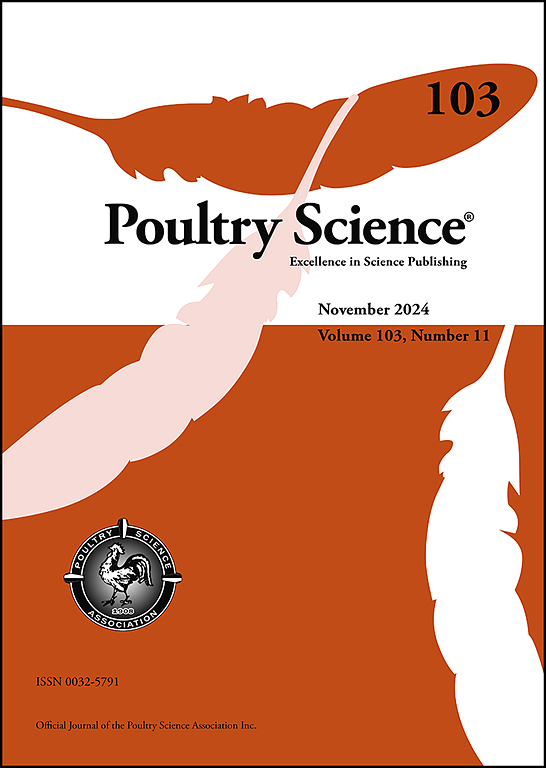Analysis of comb morphology in Sichuan Mountaineous Black-bone chickens and its correlation with growth performance
IF 3.8
1区 农林科学
Q1 AGRICULTURE, DAIRY & ANIMAL SCIENCE
引用次数: 0
Abstract
Biological ornaments, such as the comb in chickens, act as condition-dependent indicators of mate quality and are influenced by genetic, hormonal, and environmental factors. In this study, we investigated the histomorphological development of combs in Sichuan Mountaineous Black-bone chickens and examined their relationship with growth performance and hormone levels. At market age, the chickens were classified into large- and small-comb groups based on comb size, and their skeletal traits, slaughter performance, and meat quality were evaluated. The results showed that male chickens with large combs exhibited significantly better skeletal development, including greater shank circumference, breast depth, and breast circumference, although slaughter traits relative to body weight did not differ significantly. In female chickens, a similar pattern was observed in the large-comb group, but the differences were not statistically significant. Meat quality analysis revealed that male chickens with large combs had higher pH and moisture in breast muscle, while crude protein and crude fat were higher in those with smalle combs. L* value and inosine monophosphate (IMP) were more abundant in the breast muscle of female chickens with large combs. Growth hormone (GH) levels were positively associated with comb traits in both sexes, whereas testosterone showed no significant correlation. Gene expression analysis indicated that BMP2 and HSD17B2 were upregulated in small-comb chickens, while chondroadherin-like (CHADL) was upregulated in large-comb chickens. These findings enhance our understanding of the biological basis of comb development and its link to growth performance, offering useful insights for improving productivity in poultry through ornamental trait selection and economic and scientific values.
四川山地乌骨鸡鸡冠形态分析及其与生长性能的关系
生物装饰,如鸡的鸡冠,作为配偶质量的条件依赖指标,受到遗传、激素和环境因素的影响。本研究研究了四川山地乌骨鸡鸡冠的组织形态学发育,并探讨了其与生长性能和激素水平的关系。按鸡冠大小分为大鸡冠组和小鸡冠组,对其骨骼性状、屠宰性能和肉质进行评价。结果表明,大鸡冠的雄鸡骨骼发育显著更好,包括更大的腿围、胸深和胸围,但屠宰性状相对于体重没有显著差异。在雌鸡中,在大鸡冠组中观察到类似的模式,但差异无统计学意义。肉质分析表明,鸡冠大的雄鸡胸肌pH值和水分较高,鸡冠小的雄鸡粗蛋白质和粗脂肪较高。L*值和单磷酸肌苷(IMP)在鸡冠较大的母鸡胸肌中含量较高。生长激素(GH)水平与梳状性状呈显著正相关,而睾酮水平与梳状性状无显著相关。基因表达分析表明,BMP2和HSD17B2在小鸡冠鸡中表达上调,而CHADL在大鸡冠鸡中表达上调。这些发现增强了我们对鸡冠发育的生物学基础及其与生长性能的联系的理解,为通过观赏性状选择提高家禽生产效率和经济科学价值提供了有益的见解。
本文章由计算机程序翻译,如有差异,请以英文原文为准。
求助全文
约1分钟内获得全文
求助全文
来源期刊

Poultry Science
农林科学-奶制品与动物科学
CiteScore
7.60
自引率
15.90%
发文量
0
审稿时长
94 days
期刊介绍:
First self-published in 1921, Poultry Science is an internationally renowned monthly journal, known as the authoritative source for a broad range of poultry information and high-caliber research. The journal plays a pivotal role in the dissemination of preeminent poultry-related knowledge across all disciplines. As of January 2020, Poultry Science will become an Open Access journal with no subscription charges, meaning authors who publish here can make their research immediately, permanently, and freely accessible worldwide while retaining copyright to their work. Papers submitted for publication after October 1, 2019 will be published as Open Access papers.
An international journal, Poultry Science publishes original papers, research notes, symposium papers, and reviews of basic science as applied to poultry. This authoritative source of poultry information is consistently ranked by ISI Impact Factor as one of the top 10 agriculture, dairy and animal science journals to deliver high-caliber research. Currently it is the highest-ranked (by Impact Factor and Eigenfactor) journal dedicated to publishing poultry research. Subject areas include breeding, genetics, education, production, management, environment, health, behavior, welfare, immunology, molecular biology, metabolism, nutrition, physiology, reproduction, processing, and products.
 求助内容:
求助内容: 应助结果提醒方式:
应助结果提醒方式:


